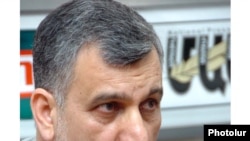The two neighboring states were thrust into turmoil by presidential elections that sparked opposition allegations of fraud and massive anti-government demonstrations. Authorities in both states resorted to lethal force and mass arrests of opposition supporters to quell the protests.
Iran’s ambassador to Armenia, Seyed Ali Saghaeyan, reiterated his government’s allegations that the worst street unrest in Tehran since the 1979 Islamic Revolution was fomented by Western powers and the United States and Britain in particular. “The United States and Britain tried to interfere but that didn’t work,” he said. “Everything has been sorted out.”
While noting that the events in Armenia and Iran are “not comparable,” Saghaeyan claimed that the West also had a hand in the unrest that followed the Armenian presidential election of February 2008. “In my personal view, the events that occurred in Armenia on March 1 last year stemmed from the West’s efforts to organize and finance revolutions in former Soviet republics,” he told a news conference. “We saw examples of that in Georgia and Kyrgyzstan. Fortunately, that was thwarted thanks to clever steps taken by Armenia’s leaders.”
Some Armenian pro-government politicians made similar claims last year. The foreign conspiracy theory was incorporated, at least initially, into the official criminal investigation into what the Armenian government called an opposition attempt to stage a coup d’etat. The Special Investigative Service (SIS), a law-enforcement agency leading the probe, claimed that opposition leader Levon Ter-Petrosian’s bid for regime change was “organized by one center” and “financed from abroad.”
Shortly after the March 2008 violence, the SIS chief Andranik Mirzoyan instructed regional prosecutors to round up participants of the post-election demonstrations in Yerevan and find out “what was said at the rallies about the assistance from foreign states” and “whether rally participants spoke about ending Russia’s presence in Armenia.”
President Serzh Sarkisian was among foreign leaders who congratulated his Iranian counterpart Mahmud Ahmadinejad on the latter’s disputed reelection. The two men agreed to press ahead with more large-scale Armenian-Iranian projects during Sarkisian’s April visit to Tehran. Those include the construction of a railway connecting the two countries and a big hydro-electric plant.
Saghayean said that the turmoil in Iran will not reflect negatively on the implementation of those projects.
Iran’s ambassador to Armenia, Seyed Ali Saghaeyan, reiterated his government’s allegations that the worst street unrest in Tehran since the 1979 Islamic Revolution was fomented by Western powers and the United States and Britain in particular. “The United States and Britain tried to interfere but that didn’t work,” he said. “Everything has been sorted out.”
While noting that the events in Armenia and Iran are “not comparable,” Saghaeyan claimed that the West also had a hand in the unrest that followed the Armenian presidential election of February 2008. “In my personal view, the events that occurred in Armenia on March 1 last year stemmed from the West’s efforts to organize and finance revolutions in former Soviet republics,” he told a news conference. “We saw examples of that in Georgia and Kyrgyzstan. Fortunately, that was thwarted thanks to clever steps taken by Armenia’s leaders.”
Some Armenian pro-government politicians made similar claims last year. The foreign conspiracy theory was incorporated, at least initially, into the official criminal investigation into what the Armenian government called an opposition attempt to stage a coup d’etat. The Special Investigative Service (SIS), a law-enforcement agency leading the probe, claimed that opposition leader Levon Ter-Petrosian’s bid for regime change was “organized by one center” and “financed from abroad.”
Shortly after the March 2008 violence, the SIS chief Andranik Mirzoyan instructed regional prosecutors to round up participants of the post-election demonstrations in Yerevan and find out “what was said at the rallies about the assistance from foreign states” and “whether rally participants spoke about ending Russia’s presence in Armenia.”
President Serzh Sarkisian was among foreign leaders who congratulated his Iranian counterpart Mahmud Ahmadinejad on the latter’s disputed reelection. The two men agreed to press ahead with more large-scale Armenian-Iranian projects during Sarkisian’s April visit to Tehran. Those include the construction of a railway connecting the two countries and a big hydro-electric plant.
Saghayean said that the turmoil in Iran will not reflect negatively on the implementation of those projects.




